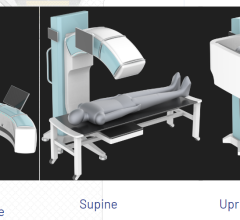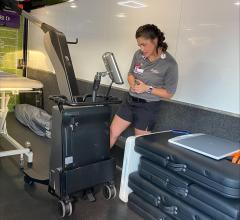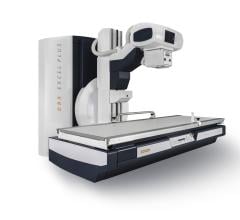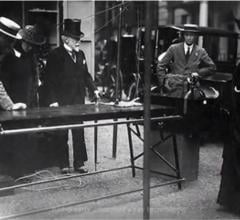The Radiological Society of North America (RSNA) 2014 meeting in December showcased many new digital radiography (DR) products. In today’s fairly stagnant economy, medical facilities are looking for ways to do more with what they already have, and stretch their budgets. In searching for new DR systems, cost-effectiveness, ease of use and flexibility top their list. Many vendors debuted solutions to meet this demand.
Cost-effective
Viztek released the ViZion + Wireless, an easy to install DR panel. It is a cost-effective option for all environments. The 14 x 17-inch panel is available for both new rooms and to retrofit existing rooms. With its ISO 4090 cassette size, the panel is designed to fit into any standard Bucky. It also features a drop reporting system. The new panel can be paired with both the ViZion and Ultra Acquire workstation software, offering features for image capture, manipulation and sending to radiologists for interpretation. The panel has a built-in router to enable wireless connectivity, eliminating outside routers to allow Wi-Fi accessibility.
Agfa launched its DX-D 40 digital detector with automatic exposure detection (AED), offering a fast and easy way for facilities to benefit from high-quality digital imaging using any X-ray equipment. Wireless and cable-free, it allows facilities to cost-effectively upgrade film and CR mobile X-ray units to DR. Installation is quick, easy and non-invasive and AED requires no electrical connection to the X-ray device.
Flexibility and Value
Konica Minolta released the ImagePilot Aero, a less expensive solution designed to meet the clinical and economic needs of orthopedic clinics. It uses the durable AeroDR wireless flat panel detector and offers advanced orthopedic toolsets. With AeroSync automatic X-ray detection or a hand switch connection, it can integrate with most X-ray systems. It also features single click automatic image processing. The detector can hold up to 660 pounds distributed across the panel. The lightweight, 14 by 17-inch wireless flat panel detector weighs 5.7 pounds and has grip strips that make it simple to maneuver between diverse exams.
Fully Automated
Carestream highlighted its latest DR system enhancements, including a new feature for its fully automated DRX-Evolution DR Room that allows operators to manually move the overhead tube with assistance from the system’s motors to reduce technologist fatigue. It also showed a ceiling-mounted tube option for its DRX-Ascend system. Software for its DRX and CR systems includes an optional bone suppression feature that can improve visibility of lung nodules. New software can collect radiation dose information using the IHE radiation dose monitoring profile and sends it to PACS. It also offers companion images that can enhance visualization of tubes, PICC lines and pneumothorax.
Light and Streamlined
Fujifilm introduced the FDR D-EVO II. Offered in 24 x 30 cm Csl, 14 x 17-inches and 17 x 17-inches, the new detectors will be available in early 2015. They are 20 percent lighter than previous models and feature a magnesium alloy enclosure for improved durability. The shape of the detectors incorporates tapered edges to simplify positioning under the patient and an IPX-6 water resistant rating. The sealed smooth surface and the battery compartment are designed to lock out moisture. The entire detector is layered with antibacterial nano-coating to reduce bacterial growth on the device. The detector also features internal memory that stores up to 100 images with or without a live connection to the workstation. This feature allows faster image acquisition for trauma use and uninterrupted exams if the wireless signal is hindered.
Transitioning Equipment
The RadPRO Delinia 200 Digital X-ray Acquisition Cart transports the Canon CXDI-701C/801C/401C wireless detectors with auto detection mode to provide a cost-effective way to transition to DR technology. The cart comes equipped with a computer, access point, touch screen monitor, detector holder and a choice of the Canon CXDI-701C, CXDI-801C or CXDI-401C wireless DR system. In X-ray auto detection mode, the detector will track X-rays at exposure and shift to image acquisition mode automatically, without the use of a typical X-ray generator interface. As a result, it can help accelerate exams by providing results within seconds, using the installed X-ray generator in an existing radiography room or a mobile generator, without the need for cabling or special interfacing. These capabilities are now portable and can be shared among multiple rooms.
New FDA Clearance
The U.S. Food and Drug Administration (FDA) cleared Siemens’ Multix Select DR — an entry-level, floor-mounted DR system. It is equipped with workflow enhancement features, including an intuitive user interface identical to Siemens’ premium DR systems. Its 14 x 17-inch mobile flat panel detector provides optimal coverage for both generalized and specialized radiographic exams. For pediatric exams, its grid can be removed to reduce patient radiation dose. The detector’s design enables placement wherever necessary, with the ability to acquire images in portrait or landscape format.
The user can choose the patient name with a single click, and the system automatically selects the organ program with the user’s individual requirements. The system’s DiamondView Plus on-board post-processing tool optimizes image processing for organ-specific examinations. Advanced tools help the user visualize fine detail in bone and soft tissue.
In addition, the FDA also recently granted 510(k) clearance to the Siemens Ysio Max, a DR system with multiple advances in X-ray (MAX), including time-saving user support features and X-ray detectors. The MAXalign feature displays the current detector angle on the system’s MAXtouch display screen, eliminating guesswork regarding the angle of the X-ray tube. With MAXalign, users can align the tube according to the detector angle shown on the screen for enhanced exam quality and consistency. MAXalign can help technologists reduce repeat exposures, saving time and resources.

 June 21, 2024
June 21, 2024 








